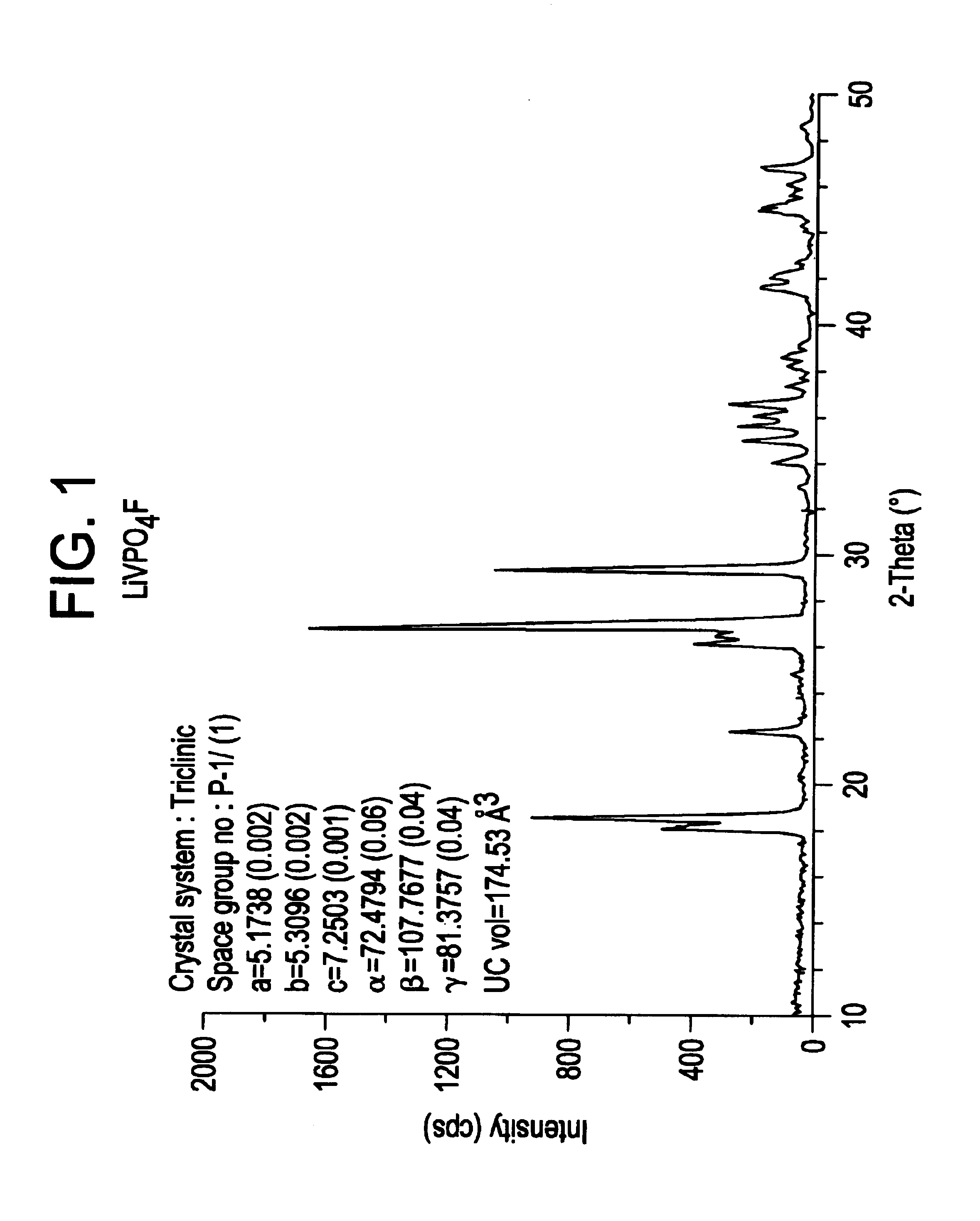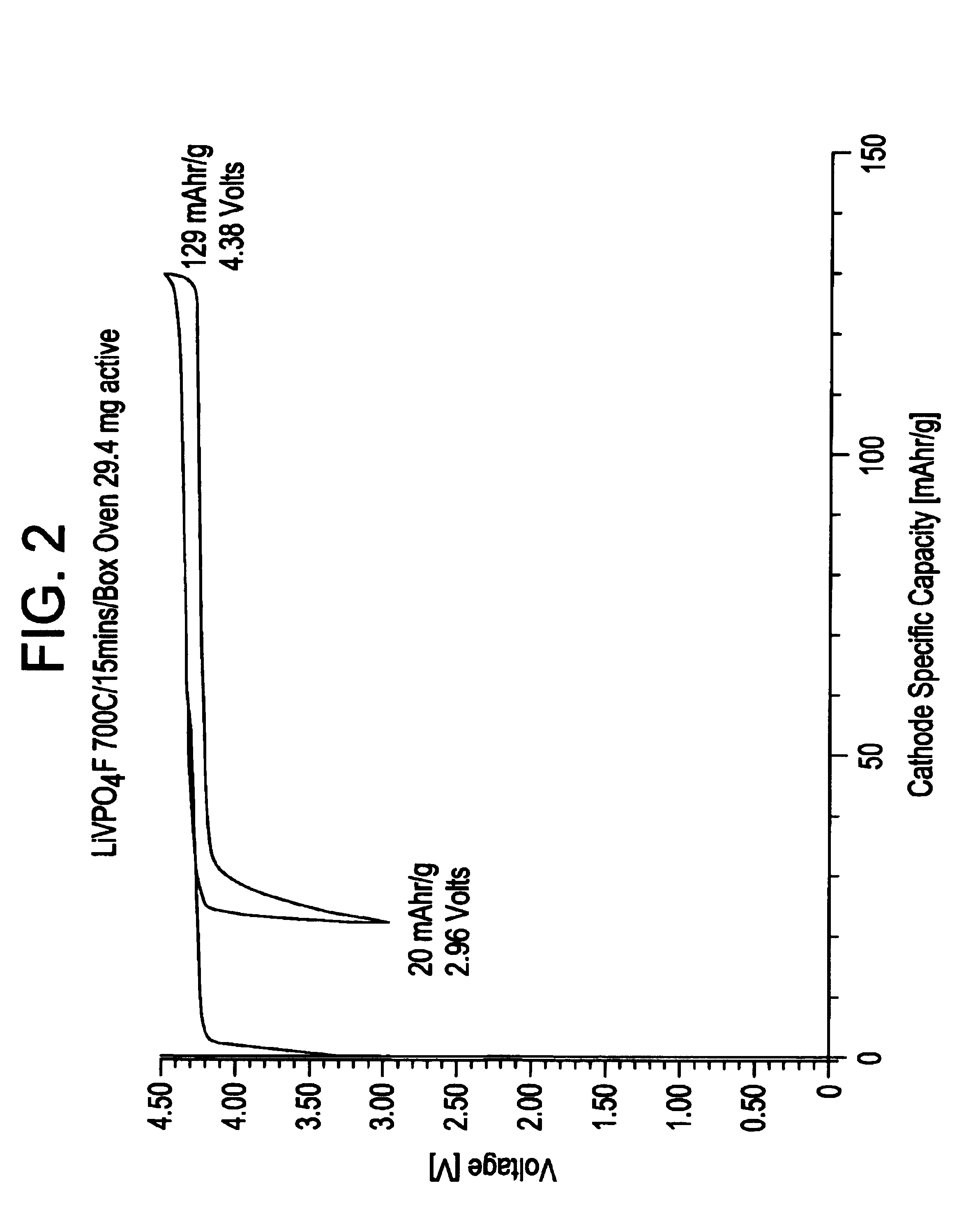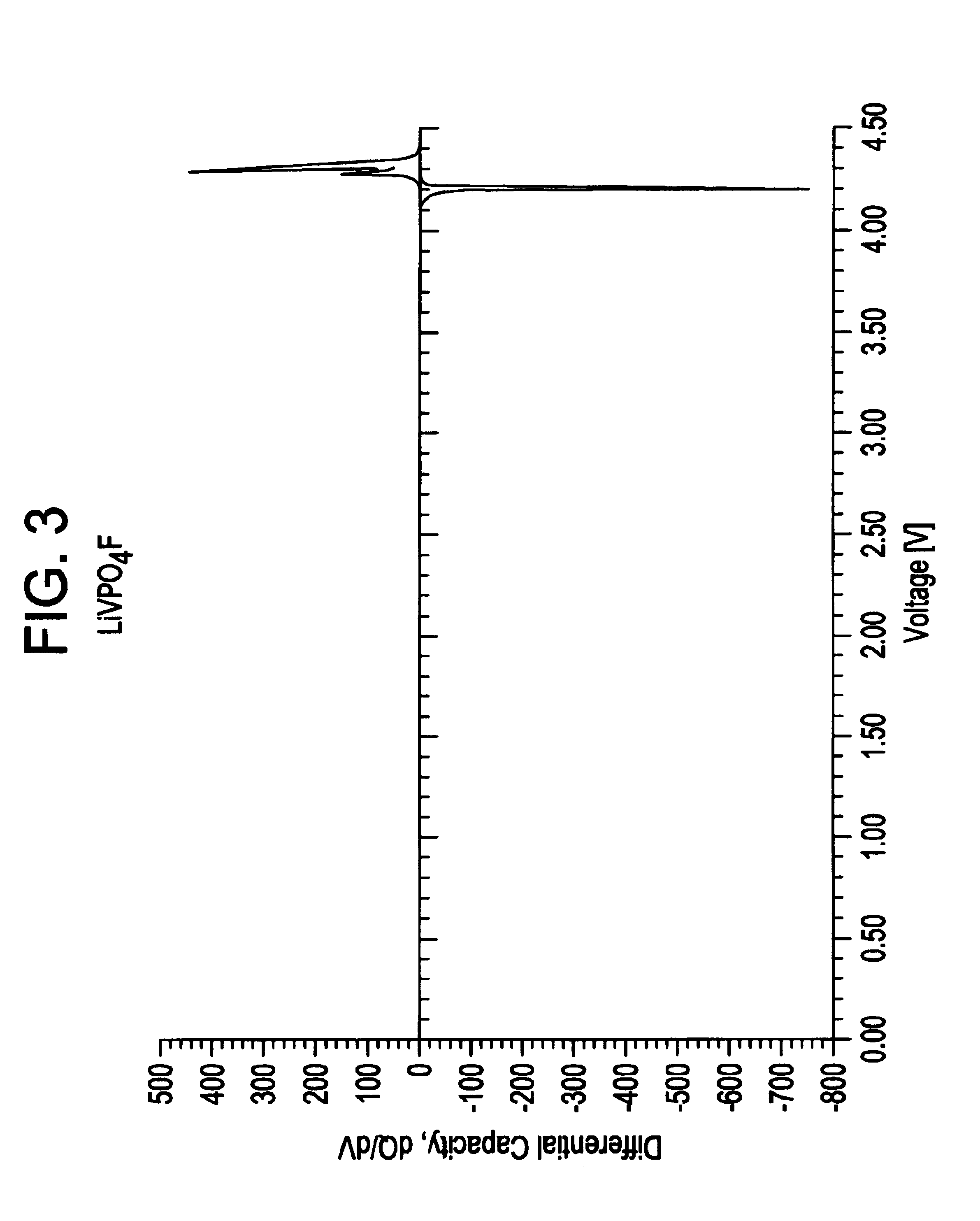Methods of making lithium metal cathode active materials
a lithium metal cathode and active material technology, applied in the direction of phosphorus halides/oxyhalides, vanadium compounds, cell components, etc., can solve the problems of relatively high cost of lithium-nickel compounds, complex and difficult synthesis of lithium-nickel compounds, and inability to meet the requirements of electrode active materials,
- Summary
- Abstract
- Description
- Claims
- Application Information
AI Technical Summary
Benefits of technology
Problems solved by technology
Method used
Image
Examples
example i
Reaction 1(a)—Using Hydrogen to Form Precursors
0.5V2O5+NH4H2PO4+H2→VPO4+NH3+2.5H2O[0074](a) Pre-mix reactants in following proportions using ball mill. Thus,[0075]0.5 mol V2O5=90.94 g[0076]1.0 mol NH4H2PO4=115.03 g[0077](b) Pelletize the power mixture.[0078](c) Heat to 300° C. at a rate of 2° C. / minute in a flowing H2 atmosphere. Dwell for 8 hours at 300° C.[0079](d) Cool at 2° C. / minute to room temperature.[0080](e) Powderize and re-pelletize.[0081](f) Heat to 850° C. in a flowing H2 atmosphere at a rate of 2° C. / minute. Dwell for 8 hours at 850° C.[0082](g) Cool at 2° C. / minute to room temperature.
Reaction 1(b)—Formation of Lithium Vanadium Fluorophosphate
LiF+VPO4→LiVPO4F[0083](a) Pre-mix reactants in equi-molar portions using a ball mill. Thus,[0084]1 mol LiF=25.94 g[0085]1 mol VPO4=145.91 g[0086](b) Pelletize powder mixture.[0087](c) Heat to 700° C. at a rate of 2° C. / minute in an air atmosphere in a covered nickel crucible. Dwell for 15 minutes at 700° C.[0088](d) Cool to room ...
example ii
Reaction 2(a)—Using a Carbothermal Method to Form Precursors.
0.5V2O5+NH4H2PO4+C→VPO4+NH3+1.5H2O+CO[0090](a) Pre-mix reactants in the following proportions using ball mill. Thus,[0091]0.5 mol V2O5=90.94 g[0092]1.0 mol NH4H2PO4=115.03 g[0093]1.0 mol carbon=12.0 g[0094] (Use 10% excess carbon→13.2 g)[0095](b) Pelletize powder mixture.[0096](c) Heat pellet to 300° C. at a rate of 2° C. / minute in an inert atmosphere (e.g., argon). Dwell for 3 hours at 3000° C.[0097](d) Cool to room temperature at 2° C. / minute.[0098](e) Powderize and re-pelletize.[0099](f) Heat pellet to 850° C. at a rate of 2° C. / minute in an inert atmosphere (e.g. argon). Dwell for 8 hours at 850° C. under an argon atmosphere.[0100](g) Cool to room temperature at 2° C. / minute.[0101](h) Powderize pellet.
Reaction 2(b)—Formation of Lithium Vanadium Fluorophosphate
LiF+VPO4→LiVPO4F[0102](a) Pre-mix reactants in equi-molar portions using a ball mill. Thus,[0103]1 mol LiF=25.94 g[0104]1 mol VPO4=145.91 g[0105](b) Pelletize po...
example iii
Reaction 3(a)—Formation of Aluminum Phosphate.
Al(OH)3+NH4H2PO4→AlPO4+NH3+3H2O[0109](a) Premix reactants in equi-molar portions using a ball mill. Thus,[0110]1.0 mol Al(OH)3=78.0 g[0111]1.0 mol NH4H2PO4=115.03 g[0112](b) Pelletize powder mixture.[0113](c) Heat to 950° C. at a rate of 2° C. / minute in an air atmosphere. Dwell for 8 hours at 950° C.[0114](d) Cool to room temperature at about 50° C. / minute.[0115](e) Powderize.
Reaction 3(b)—Formation of Lithium Vanadium Aluminum Fluorophosphate
0.9VPO4+0.1AlPO4+1.0LiF→LiV0.9Al0.1PO4F[0116](a) Pre-mix reactants in the following proportions using ball mill. Thus,[0117]0.9 mol VPO4=131.3 g[0118]0.1 mol AlO4=12.2 g[0119]1.0 mol LiF=25.9 g[0120](b) Pelletize powder mixture.[0121](c) Heat to 700° C. at a rate of 2° C. / minute in a nickel crucible in either an air or inert atmosphere. Dwell for 15 minutes at 700° C.[0122](d) Cool to room temperature at about 50° C. / minute.[0123](e) Powderize.
PUM
| Property | Measurement | Unit |
|---|---|---|
| temperature | aaaaa | aaaaa |
| temperature | aaaaa | aaaaa |
| voltage/capacity | aaaaa | aaaaa |
Abstract
Description
Claims
Application Information
 Login to View More
Login to View More - R&D
- Intellectual Property
- Life Sciences
- Materials
- Tech Scout
- Unparalleled Data Quality
- Higher Quality Content
- 60% Fewer Hallucinations
Browse by: Latest US Patents, China's latest patents, Technical Efficacy Thesaurus, Application Domain, Technology Topic, Popular Technical Reports.
© 2025 PatSnap. All rights reserved.Legal|Privacy policy|Modern Slavery Act Transparency Statement|Sitemap|About US| Contact US: help@patsnap.com



